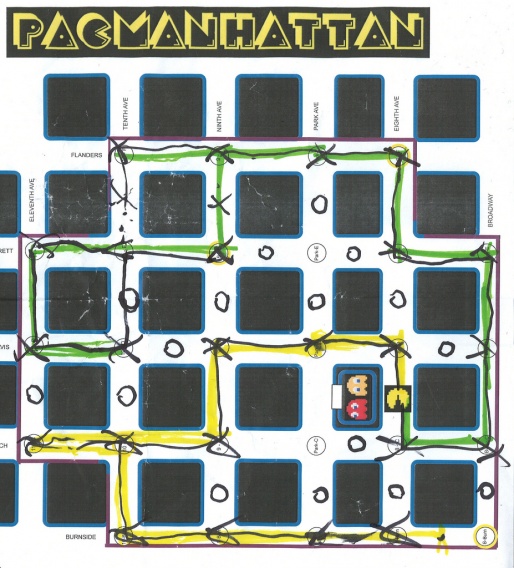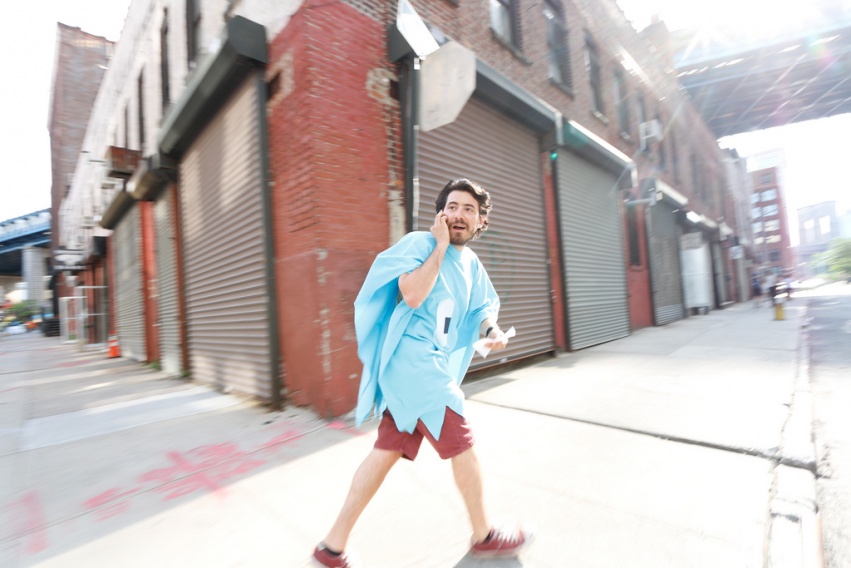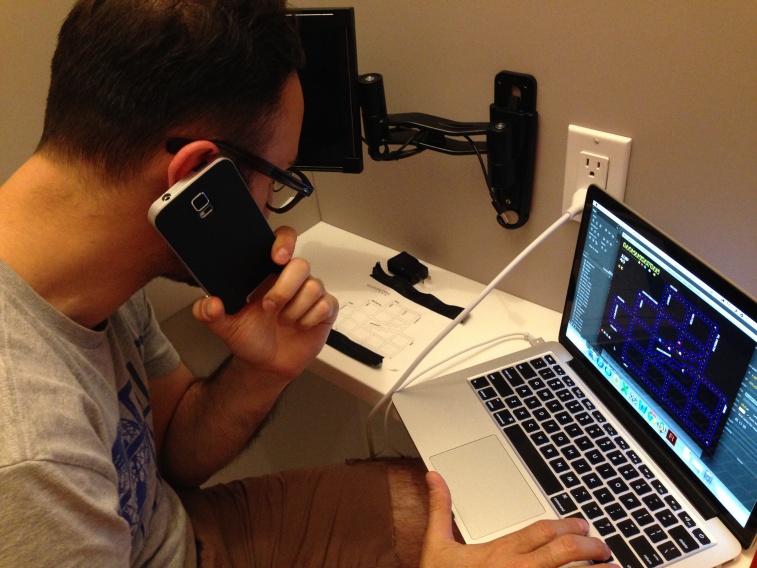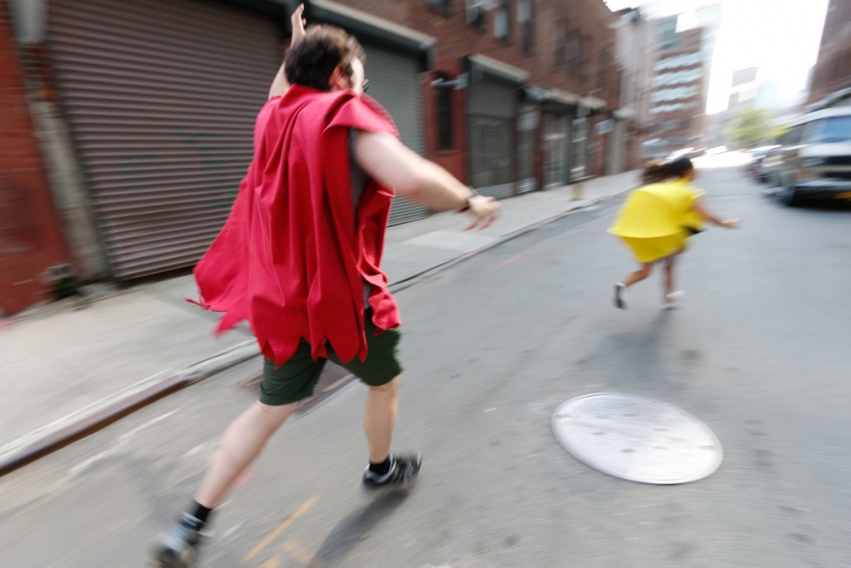PacManhattan Runs Again!
Posted July 23, 2014
The 10th Anniversary of PacMahattan saw the live action urban game turn the streets of DUMBO into ghost filled, dot-gobbling pathways.
I was in a class called Big Games with NYU professor Frank Lantz in 2004. There were eleven of us in the class and we decided to work on our final project as a group. While brainstorming, someone said (not me), “Why not do something called Pac-Manhattan?” Initially the idea was based on the name because we all thought that it sounded cool.
We looked at maps and found that the area right around Washington Square Park looks like a Pac-Man grid — so we took that as inspiration and ran with it. We came up with ways of creating the game with people playing the roles of the ghosts and Pac-Man and conceived of a lot of really high tech stuff to make it work.

When Frank returned to class, we told him our pitch. It involved using GPS tracking and instant communications and so forth, but none of us really had the skills or time to develop the technology required. Then Frank proposed that we play the game with ten minutes of planning. We had to solve the problem in an analog way and we did. In ten minutes, we were playing the game with phones, paper maps, and pennies to track player progress. We discovered that the game was a lot of fun. The lesson was not to lead with the technology but to lead with the fun, to find the fun and follow it.
For the larger game, we developed an app using Director, otherwise known as Shockwave. It was a really cool programming language that was easy to use, not too dissimilar from Flash. Using that program, we developed the controller stations that half of the players used. The other half of the players were on the ground, in costumes, running around the streets. Both sets of players were on the phone with each other, one controller to each ghost and one for Pac-Man.
The game itself, as it was created ten years ago and played just last weekend, is a ten player game. Five players are on the streets. Four of them are ghosts, Inky, Blinky, Pinky, and Clyde. One of them is Pac-Man or Ms. Pac-Man. The ghosts and Pac-Man put on costumes for their characters. The five other players are the controllers and they play inside a control room at computer stations. The ghost controllers are all together in one room each with a special computer app for their character. The Pac-Man controller is in a separate room with her or his own app. The goal for Pac-Man is to score the most points. The goal of the ghosts is to catch Pac-Man.

When a player is on the street they have such a limited view. They have a paper map of the play area and a phone to talk to their controller, but have little information beyond what they can see. The controllers’ job is to tell the ghosts and Pac-Man how to succeed at their goal. The ghost controllers have a screen with a play area map and they continuously update the map according to where their player is on the real streets. The phone conversations are two way information flows. Players tell the controllers where they are, and the controllers tell the players where everyone else is and help develop larger scale strategy.
The ghost controllers can see where all the other ghosts are. They can also talk to the other controllers and devise plans and strategies based on all the information that is coming in. Additionally, they have the ability to see if Pac-Man has been in one part of the play area recently through a hot / cold detector. If they move their ghost to a part of the play area, they might receive a message that says, “warm, warmer, or hot,” depending on whether or not Pac-Man has been there recently. This gives them a little insight into the movements of Pac-Man, since he does not show up on their screens.
On the Pac-Man side, the goal is to score as many points as possible. The team scores points by eating virtual dots or eating the ghosts. The dots show up on the player’s paper map and on the controller’s screen. Both of them know where all the dots and the larger power pellets are located. The way to score the most points is to get a power pellet and catch the ghosts just like the arcade game. But unlike the arcade game, that is the hardest way to play. In the live action version, that would entail running many miles and catching four other people who can run away from you. The other Pac-Man strategy is to use the power pellets as safety nets to get to all the other, smaller dots.
The first game that we played ten years ago in Washington Square Park involved almost four miles of running. It was a large board. After we worked out how to play in an analog fashion, we did a play test one weekend. A reporter from Wired was there to watch. A fellow student at ITP (NYU’s Interactive Telecommunications Program) put a short video of what we were doing on slashdot. Because of the coverage and the video, the game went viral. When we played if for real the next weekend, the New York Times and several other media outlets covered us. There was a huge media spike. It was funny because we only played it with each other and some reporters. We never got to play it with the general public!
After our first play, there were dozens of other cities that made their own versions of PacManhattan. We put all the files and instructions out there for others to use. It started to become part of the cultural consciousness when it came to live action experiences in an urban environment. Even now, if you search PacManhattan, someone is using it as an example when writing about anything from augmented reality to live action arcade games. It is the go-to game that everyone knows about and latches onto. But we never played it in NYC again.
It was pointed out to me in January of this year that it was going to be the 10th anniversary of the game. Every now and again, throughout those ten years, the group of eleven and Frank would mention getting the game back together, but it never happened. Since it was the tenth anniversary, I figured that we should get it together for real and see what we could do. The NYU Game Center, now run by Frank, bought the two PacMan costumes, helped get the word out through marketing and also secured a nice piece in the New York Daily News. I created the software from scratch and ran the event with the help of fellow ESI designers, Jessica Fiorini and Debra Everett-Lane. My wife, Meghan, made the ghost costumes.
What was really cool about this iteration of PacManhattan was that I got to redo the software, making it much better than the original. It looked a lot nicer and had a lot of new features. You could really control Pac-Man and the ghosts on the grid. The previous version only allowed you to track and move the characters at the intersections, which meant that there were large gaps in your knowledge. While that is kind of cool, because it means that you don’t have to be as precise, I’m was hoping to move towards a place where we can use cutting edge technology to track the players. This iteration is a step in that direction. Having that fine-tuning of where the ghosts and Pac-Man are in space really made it feel more authentic. And it made the whole game a lot more intense. The scoring was also much more accurate. In the end the game ended up playing almost exactly the same. There was a software app and people were on phones with people on the street. The people in the control rooms were updating the location of the ghosts and Pac-Man.

We were able to stage this 10th anniversary play in DUMBO. And the reason we were there is because that is where Come Out and Play’s Night Games Festival was taking place. I wanted PacManhattan to act as a lead in for the festival, since it is played during the day, and the neighborhood provide a great grid.
Another really nice aspect of playing in DUMBO is that the neighborhood is beautiful. A spectator posted an excellent picture of a ghost running and you can see the Manhattan Bridge in the background. You don’t get those kinds of views when you are near Washington Square Park, in the center of Manhattan. You do get the arch, but there are more spectacular scenic things that happen when in DUMBO. So it made the experience really nice.
On July 18th, we placed our main control room at 30 John Street, in the Made in NY Media Center by IFP, an arts and media incubator and shared workspace. This is where Playmatics has some office space, and the ghosts were set up here. The Pac-Man controller was set up in a sound isolation booth that will shortly become a Verizon video call booth. It was a funny thing for the Pac-Man controller to be in there because he or she was totally isolated and it added to the tension of the game.
When you are a controller, you don’t really get what you are doing at first. You think, “Am I telling the ghosts where to go, or am I just recording what they are doing?” But then, after a little while the process clicks. It starts to feel like you are connected to the person running outside. And since you can’t see what they see, but you have information — you know where all the other ghosts are, that someone has seen Pac-Man — you are trying to paint a picture of what their experience looks like in your head. And the players are using the information the controller gives them to make real moves. It creates a rich tension and connection between controller and character. If something happens, like the character starts yelling into the phone, “Oh my gosh, I see him,” and then starts running, the controller is then trying to decode what the character is saying and give them the information that will help them do better. These actions are done simultaneously and throughout the game.

The universal reactions that we heard from the players were that even when they were inside the control room, it was a crazy experience that made your heart beat fast. At first, the controllers were sitting back in their chairs, but I saw them slowly lean forward and tense up, moving toward the screen where the virtual action was taking place. The people who were controllers always had a lot of fun. They always felt good tension. They always felt a really strong connection to their player. It was interesting to see how people communicated, in pairs and the large group, especially because they were in a room with other people shouting on the phone. There was cacophony in the space.
And then on the ground everyone had fun because, one, everyone was running around in these costumes, which are a very, very popular aspect of the game. There are now thousands and thousands of photos of players in the costumes and games were delayed because every player wanted to get a couple more photos of themselves in the outfits. The second reason the players had fun was because of the great excitement of the game. One of the Pac-Man players told me that it was one of the scariest experiences of his life, in a good way. He was running down the road away from one ghost and another ghost came out from behind a car. The player was a big dude and it was funny to hear that from him. He was terrified. He got so into it. I think that everyone got really into it. We had one kid play as Pac-Man. He was maybe 11 or 12 and he got a really high score for eating a ton of dots. His advantage was being shorter and harder to see. But he cried when he got caught, because he didn’t realize that it would be inevitable to be caught by four adult ghosts chasing you. He thought maybe he was going to be the first one to succeed.

The 10th anniversary of PacManhattan was played for seven and a half hours. In the end I had to turn people away, because the conditions for playing were deteriorating. It is not a game meant to play in the dark. People came just to play the game and were staying to take part in the rest of the Come Out and Play Night Games festival. It was a huge hit and I will have to put it on again sometime. It was clearly something that there was a demand for and was something that people instantly understood and wanted to participate in. There were people there from education and other game developer organizations that came just to watch other people play, to peek at it. Frank writes and lectures about this stuff it in academia, so it was kind of neat to bring it to life for other people and show them what it looked like and how it felt.


Join The Conversation